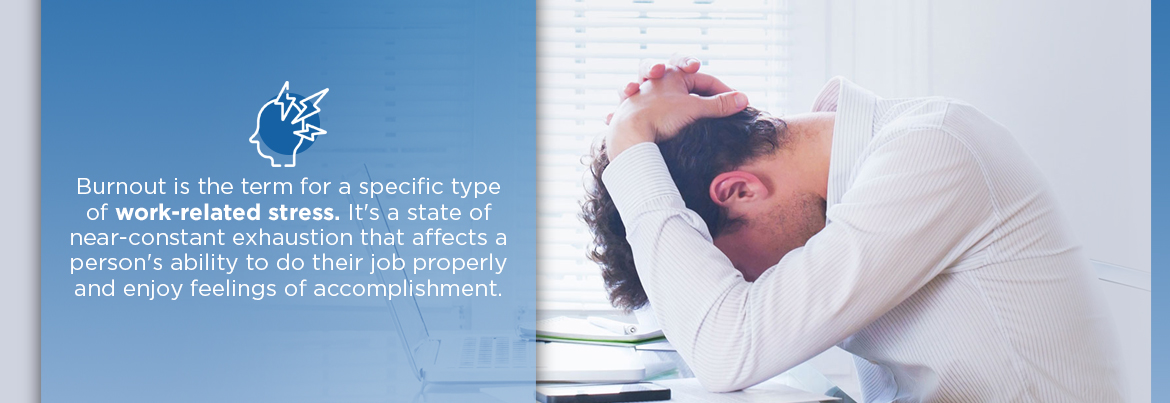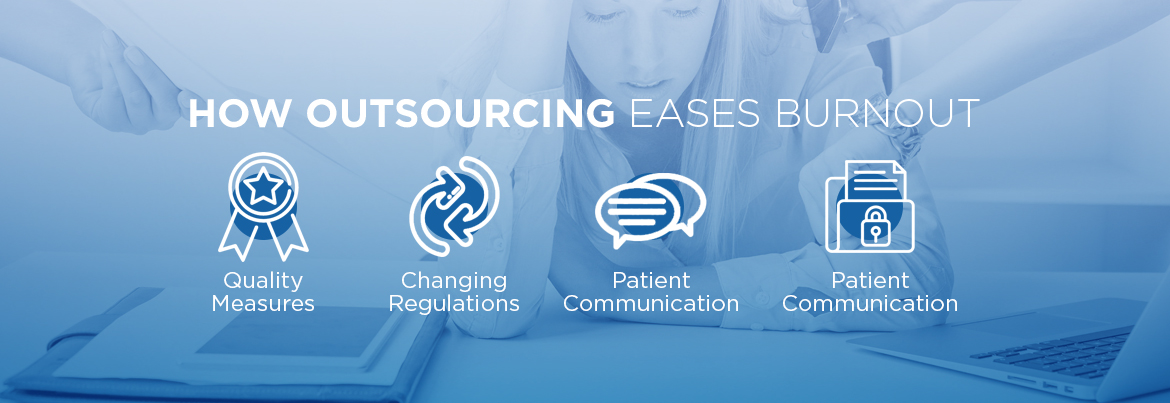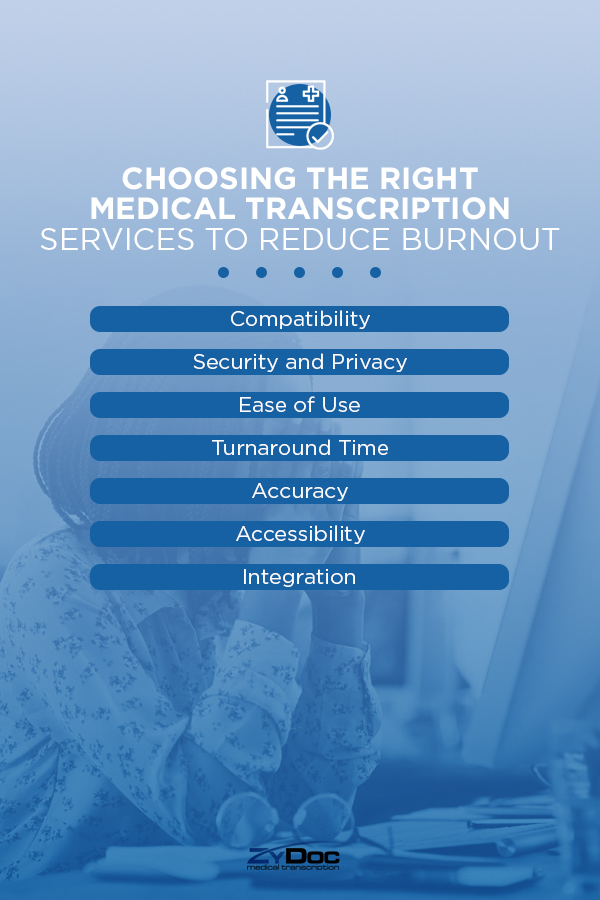How to Prevent Burnout as a Healthcare Professional
Nov 14, 2019 | Jonathan Maisel
Working in medicine is deeply rewarding, but it undeniably causes significant stress. Doctors are dealing with life-or-death situations every day, and this type of work can result in physicians developing burnout. The consequences of burnout can be severe, and preventing it keeps doctors from performing at their best. We’ll take a look at the causes and effects of burnout, and investigate how medical transcription services can help reduce the burden on physicians.
What Is Burnout?

Burnout is the term for a specific type of work-related stress. It’s a state of near-constant exhaustion that affects a person’s ability to do their job properly and enjoy feelings of accomplishment. Burnout is also associated with a loss of personal identity. Signs of burnout include:
- Being cynical or overly critical
- Having trouble getting started at work
- Lacking the energy required for consistent productivity
- Difficulty concentrating on work
- Lacking satisfaction from achievements
- Using food, alcohol or illicit substances to feel okay
- Experiencing altered sleep habits
- Having unexplained physical ailments like headaches or stomach problems
In short, burnout makes doctors miserable, and that affects their ability to do their jobs. Burnout stems from a variety of sources. Here are some of the possible causes:
- No control: Some physicians feel they have little influence over their work. An unrealistic schedule and extreme workload can contribute significantly to burnout.
- Unclear expectations: Especially in large practices or hospitals, doctors can feel unsure about what administrative duties they have outside of interacting with patients.
- Dysfunctional dynamics: Ideally, everyone in a practice gets along at least on a professional level. However, micromanaging or misuse of authority take a toll on everyone in the practice.
- Constant activity: Doctors often work in hectic environments where the action never stops. Operating at this heightened level day in and day out can easily cause stress-induced burnout.
- Lacking social support: Doctors without an emotional support system have fewer outlets for their feelings and frustrations.
- Tedious tasks: Physicians who spend too much time on tasks like creating patient notes often feel their time could be better spent elsewhere.
Burnout is a serious problem for productivity in any industry, but it disproportionately affects physicians. A 2019 report on burnout and depression in doctors reveals that more than 40% of physicians are burned out. Even worse, 39% say they are simply too busy to seek help for their burnout. While burnout is not a medical diagnosis, it does have some hallmarks including depression. Around 11% of doctors experience symptoms of depression, and it affects their ability to provide care.
Among depressed doctors, 35% say they are more easily exasperated with patients in their care. Another 26% say they are less motivated to be careful when creating patient notes, and 14% make mistakes they wouldn’t make if not burned out.
Colleagues and practice staff also feel the effects of physician fatigue and burnout. About 47% of physicians report being more irritable and easily exasperated by coworkers, and 40% say their burnout has led to expressions of frustration in front of coworkers.
A Stanford University study of nearly 7,000 physicians revealed that 10% had made at least one serious medical error in the past three months. Doctors with burnout were more than twice as likely to make a mistake, even when adjusting for factors like work hours, fatigue, specialty and the safety of their work unit. Not being able to focus on or engage with work leaves patients vulnerable to potential errors.
It’s clear that burnout is a problem of epidemic proportions, and it’s affecting the quality of care patients can receive as well as causing talented professionals to suffer.
Can Outsourcing Certain Tasks Ease Physician Burnout?

Burnout frequently stems from doctors feeling like they have too much to do and not enough time to do it. For example, doctors spend around half of their time working on electronic health records (EHRs) rather than interfacing directly with patients. Choosing to outsource certain tasks can help address the following challenges in a medical practice.
1. Quality Measures
The Merit-based Incentive Payment System (MIPS) is a measure that rewards doctors for delivering quality care and improving outcomes for their patients. Since 2018, 10% of a physician’s MIPS score is based on claims data. For many physicians, this can be a significant challenge. The data a doctor needs to prove that they’re meeting the MIPS quality measures takes a lot of organizing, and it must be both verifiable and accurate. Outsourcing medical billing can save doctors hours a day while ensuring the relevant data is sufficient to meet quality standards.
2. Changing Regulations
Practices have to keep up with a constantly evolving reimbursement landscape. One example of this the growing trend of bundled payments. In addition, practices must also pay attention to alternative payment models and the growing popularity of tiered and narrow networks as more patients begin to expect better transparency on pricing. Outsourcing helps practices remain competitive in the face of new regulations.
3. Patient Communication
While EHRs have in many cases improved the volume and quality of information in a patient’s medical record, most doctors become frustrated with the way the technology affects the way they interact with patients. It can be difficult to find the right balance between entering the necessary data into the EHR and talking to the patient. Outsourcing medical transcription duties gives physicians more time to create a personalized experience with patients. It also increases patient satisfaction by reducing the doctor’s level of distraction.
4. Data Security
The number of data breaches in healthcare just keeps rising. Data breaches involving more than 500 patient records increased from 199 in 2010 to 365 in 2018, and there is no reason to believe the number won’t keep growing. The cost of a data breach can easily run into the millions of dollars in addition to reputational damage. While practice staff must be trained in HIPAA, they are not likely to be experts in data security. By outsourcing tasks such as billing, coding and transcription, practices can ensure they are remaining compliant and their records are guarded by data security best practices.
Can Medical Transcription Services Ease Physician Burnout?

Outsourcing transcription is one of the best possible ways to reduce burnout or even prevent it altogether. These benefits clarify the value transcription services can have for any practice.
1. Smooth Transition to EHR
One of the biggest reasons doctors struggle with stress and burnout is the transition to an EHR. Doctors aren’t trained to fill out documents and paperwork — they’re focused on making sure their patients receive the best possible care. EHRs offer the advantage of more comprehensive data on patients, which doctors can then use to improve outcomes, but it’s not always easy to transition to a new system.
Medical transcription services take the hassle out of patient notes, removing one obstacle standing in the way of proper and complete EHR adoption. Instead of point and clicking, doctors can simply dictate notes to populate their EHR.
2. Saved Time
Doctors are busy people, and wasting time is not something they enjoy when they have a roster full of patients to diagnose and treat. Spending half of their day typing up notes is a surefire way to reduce their satisfaction with their job and bring on signs of burnout. Outsourcing transcription frees up time that physicians can use to do what they do best — work with patients.
3. Better Quality Care
Medical transcription requires a high degree of expertise, and accuracy is a non-negotiable necessity. Doctors can make mistakes when taking notes day in and day out, but outsourced transcription can ensure those mistakes don’t make it into the final record.
To ensure complete accuracy, quality transcription services start with a speech recognition draft and work quickly to find any errors, omissions or possible conflict within each document. The attention to detail is instrumental in making sure physicians are working with correct information, allowing them to make better decisions for their patients. When doctors feel confident in their notes, they’re more confident in their care. Keeping that level of confidence can make the difference between burnout and sustained job satisfaction.
How Do You Choose the Right Medical Transcription Service?
Outsourcing your transcription can bring burnout levels down, but only if you choose the right service. These are a few of the factors to consider when deciding on a medical transcription company like ZyDoc.
1. Compatibility
Some transcription companies only work with certain EHRs, leaving many practices out of luck. Other services won’t work with practices that don’t use an EHR at all. The right service is invested in compatibility with every EHR and is also willing and able to provide transcription for practices that haven’t adopted an EHR yet.
2. Security and Privacy
Transcriptionists are handling sensitive personal information, so it’s imperative that they have adequate training to handle the job above and beyond HIPAA compliance. ZyDoc’s employees, typists and editors all participate in HIPAA training and testing. All your data is encrypted and protected by audit logs as well as other security measures.
If a company doesn’t provide adequate training, you might not know until your data is subject to a breach. A robust approach to security and privacy is essential for any reputable transcription service.
3. Ease of Use
A medical transcription service isn’t any good if doctors can’t figure out how to use it. Some have complex interfaces that make it just as labor-intensive as taking notes manually. With ZyDoc, physicians have options for how they dictate, all with an intuitive and easy-to-use presentation that can be picked up in minutes. There’s no software installation required, and doctors can dictate using a smartphone app, standalone voice recorder or even a regular phone line.
4. Turnaround Time
When it comes to patient records, time is often of the essence. Doctors don’t want to wait days to get back their transcriptions, yet many companies don’t put much emphasis on timely returns. ZyDoc is unique in offering the option for two-hour turnarounds on 90% of jobs, so doctors can get their transcripts quickly. When insurance companies try to delay processing claims by asking for detailed documentation, your practice can present the requested information in a timely fashion and ensure reimbursement.
5. Accuracy
Transcripts must be as accurate as possible to ensure the most effective management of the revenue cycle. ZyDoc achieves an accuracy rate of 99.6% through the use of cutting-edge technologies in addition to human eyes. The technology applies common phrases specific to individual physicians to the speech recognition draft, and transcriptionists correct grammatical errors in the initial dictation. With accurate transcription, physicians don’t have to worry about careless errors in their documentation leading to denied claims and lost revenue.
6. Accessibility
Some transcription services require software to work, which greatly diminishes the situations in which they can be used. ZyDoc’s service is browser-based, so physicians can access audio and text from any device, with any browser. This convenience can reduce the instances where doctors may be frustrated when faced with a new device that doesn’t have the appropriate software.
To ensure the safety and security of the data, user access and account privilege can be controlled on a granular level. Doctors can easily access text and audio from anywhere with an internet connection, but only if they have the correct privileges. This feature is crucial for HIPAA compliance.
7. Integration
A good medical transcription service can be integrated directly with your EHR. It can automatically insert the completed job in the correct section of your EHR, minimizing time spent on the organizational front. However, the system is also a standalone repository of information based in the cloud. Even when your EHR is inaccessible for any reason, physicians can use the transcription service to review finished work or fax over a document requested by insurance.

Can ZyDoc Medical Transcription Help You?
A medical practice is nothing without its team of dedicated doctors, and it’s essential to give them all the tools they need to do their best work. Burnout may be an incredibly common result of high-pressure work in the medical field, but it doesn’t have to define your doctors. Between regulatory pressure to adopt EHRs and the time spent manually creating patient notes, the chances are the doctors in your practice are going to experience burnout sooner rather than later.
ZyDoc is a medical transcription service created by a retinal surgeon, so we understand what pressures physicians face and what features benefit them. For example, we offer the ability to modify templates to best suit your needs, such as by developing expanded text like a frequently-used paragraph that you can insert into documentation using a single word or phrase.
ZyDoc is a leader in customer service, with thousands of happy clinicians ranking us number one in customer service and support in the “2018 Top Medical Transcription and Technology Services & Documentation Solutions” survey conducted by Black Book Market Research. If you’re ready to reduce burnout and unburden the physicians in your practice, contact ZyDoc for more information. Explore our plans and pricing to get a better idea of which service tier is best for your practice and request a free trial.
